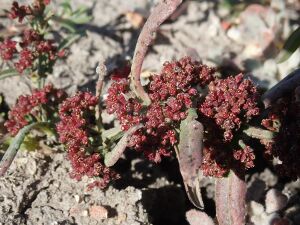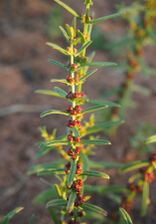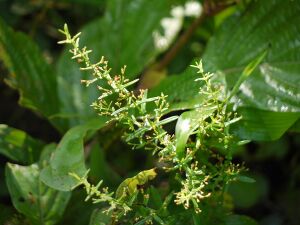Biology:Ammannia multiflora
| Ammannia multiflora | |
|---|---|
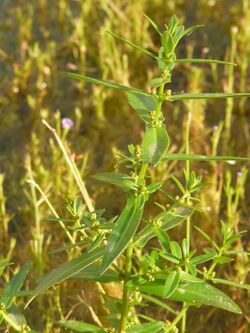
| |
| Scientific classification | |
| Kingdom: | Plantae |
| Clade: | Tracheophytes |
| Clade: | Angiosperms |
| Clade: | Eudicots |
| Clade: | Rosids |
| Order: | Myrtales |
| Family: | Lythraceae |
| Genus: | Ammannia |
| Species: | A. multiflora
|
| Binomial name | |
| Ammannia multiflora | |
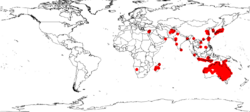
| |
| Occurrence data from GBIF | |
Ammannia multiflora, commonly known as many-flower ammannia[4] and jerry-jerry in Victoria,[5] is a species in the family Lythraceae. It is widespread in Asia, tropical and sub-tropical Africa and Australia. It can be found in shallow water and damp heavy soils.[6]
Description
Ammannia multiflora is an erect, branched herb which grows to a height of about 60 cm. The leaves are opposite, and without stalks (sessile). The leaf blade is oblong-linear to narrowly lanceolate or oblanceolate, and from 0.5 to 5 cm long, with a heart-shaped base. The inflorescences occur in short dense clusters. The sepals are triangular and about. 0.2 mm long, with the petals being about 0.5 to 1 mm long. There are 4 stamens. The capsule is globular and from 1.5 to 2.5 mm in diameter.[6]
Distribution
In Australia, it is found in Western Australia, the Northern Territory, South Australia, Queensland, New South Wales, and Victoria.[6]
Conservation status
While its conservation status under the IUCN redlist is of "least concern",[1] in Victoria it is considered "vulnerable".[5]
Uses
In Australia, Aborigenes ground its seed and baked the resultant meal to make cakes.[6]
Gallery
References
- ↑ 1.0 1.1 Zhuang, X. (2014). "Ammannia multiflora". IUCN Red List of Threatened Species 2014: e.T168705A13564728. doi:10.2305/IUCN.UK.2014-1.RLTS.T168705A13564728.en. https://www.iucnredlist.org/species/168705/13564728. Retrieved 19 November 2021.
- ↑ "Ammannia multiflora". Australian Plant Name Index (APNI), IBIS database. Centre for Plant Biodiversity Research, Australian Government. https://biodiversity.org.au/nsl/services/rest/name/apni/85826.
- ↑ Roxburgh, W. (1820). Flora Indica; or descriptions of Indian Plants, by the late William Roxburgh. 1. p. 447. https://biodiversitylibrary.org/page/787721.
- ↑ English Names for Korean Native Plants. Pocheon: Korea National Arboretum. 2015. pp. 350. ISBN 978-89-97450-98-5. http://www.forest.go.kr/kna/special/download/English_Names_for_Korean_Native_Plants.pdf. Retrieved 25 January 2016.
- ↑ 5.0 5.1 Jeanes, J.A. (1996). "Lythraceae. In: Walsh, N.G.; Entwisle, T.J. (eds), Flora of Victoria Vol. 3, Dicotyledons Winteraceae to Myrtaceae". Inkata Press, Melbourne.. https://vicflora.rbg.vic.gov.au/flora/taxon/7e022829-0c40-45ac-b987-78048e6cffa2.
- ↑ 6.0 6.1 6.2 6.3 Hewson, H.J. (2020). "Ammannia multiflora. In: Flora of Australia". https://profiles.ala.org.au/opus/foa/profile/Ammannia+multiflora.
External links
- Ammannia multiflora occurrence data from GBIF
- Ammannia multiflora Australian occurrence data from AVH
Wikidata ☰ Q10933016 entry
 |

